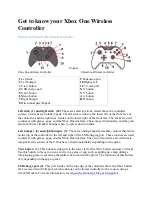
2.2. Securing the Stage to the Mounting Surface
DANGER: Mechanical Hazard!
Personnel must be made aware of the mechanical hazards during set up or when you
do service to the stage.
l
Do not manually move the stage if it is connected to a power source.
l
The stage must be mounted securely. Improper mounting can result in injury and
damage to the equipment.
l
When you move the tabletop manually to do maintenance, this could expose the
operator to pinch points. Refer to
on
The mounting surface must be flat and have adequate stiffness to achieve the maximum
performance from the stage. When it is mounted to a non-flat surface, the stage can be distorted
while the mounting screws are tightened. This distortion will decrease overall accuracy. Adjustments
to the mounting surface must be done before the stage is secured.
Inspect the mounting surface for dirt or unwanted residue and clean if necessary. Use precision
flatstones on the mounting surface to remove any burrs or high spots. Clean the mounting surface
with a lint-free cloth and acetone or isopropyl alcohol and allow the cleaning solvent to completely
dry. Gently place the stage on the mounting surface.
IMPORTANT
: The stage is precision machined and verified for flatness at the factory.
l
Do not machine the stage housing. If you must machine a surface to achieve a
required flatness, machine the mounting surface.
l
Keep the use of shims to a minimum when you mount the stage to the mounting sur-
face. The use of shims could reduce the rigidity of the system.
Table 2-1:
Stage Mounting Surface Flatness Requirement
Stage
Flatness Requirement
All Frame Sizes
5 µm
APR100DR series stages have a fixed mounting pattern available to secure the stage to a mounting
surface.
shows the main mounting holes in the base of the stage. Tightening torque values
for the mounting hardware are dependent on the properties of the surface to which the stage is
being mounted. Values provided in
are typical values and may not be accurate for your
mounting surface. Refer to
for specific model mounting locations and dimensions.
Table 2-2:
Stage to Mounting Surface Hardware
Mounting Hardware
Typical Screw Torque
M5 SHCS
4 N·m
APR100DR
Hardware Manual
20
www.aerotech.com
Summary of Contents for APR100DR Series
Page 1: ...Revision 2 00 APR100DR High Precision Mechanical Bearing Rotary Stage HARDWARE MANUAL...
Page 21: ...Figure 2 2 APR100DR Stage Mounting Holes Hardware Manual APR100DR www aerotech com 21...
Page 23: ...Figure 2 3 Cantilevered Load Capabilities Hardware Manual APR100DR www aerotech com 23...
Page 24: ...This page intentionally left blank APR100DR Hardware Manual 24 www aerotech com...
Page 32: ...Figure 3 3 APR100DR Motor and Feedback Wiring E4 APR100DR Hardware Manual 32 www aerotech com...
Page 40: ...This page intentionally left blank APR100DR Hardware Manual 40 www aerotech com...
Page 44: ...Figure 4 1 APR100DR Limit Flag Adjustment APR100DR Hardware Manual 44 www aerotech com...
Page 52: ...This page intentionally left blank APR100DR Hardware Manual 52 www aerotech com...
















































